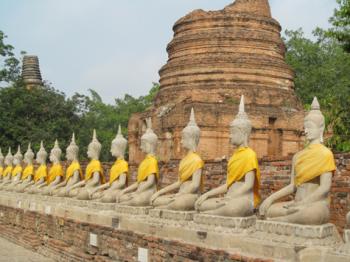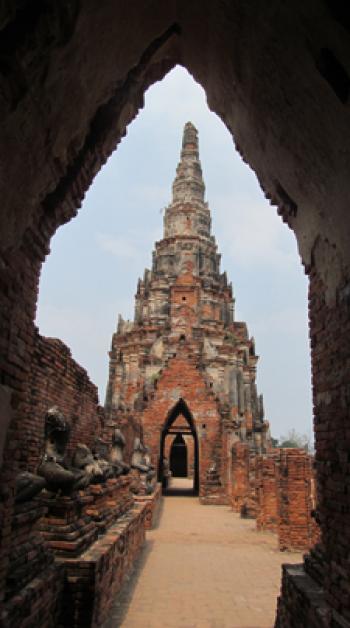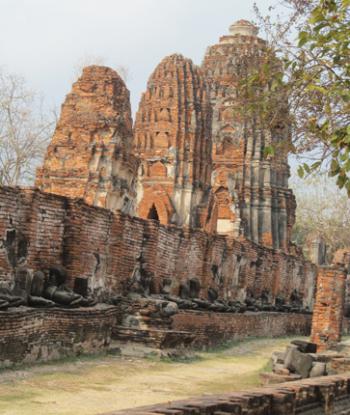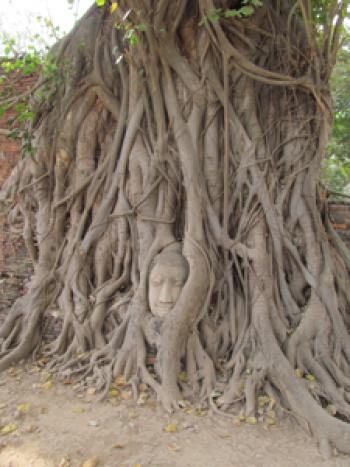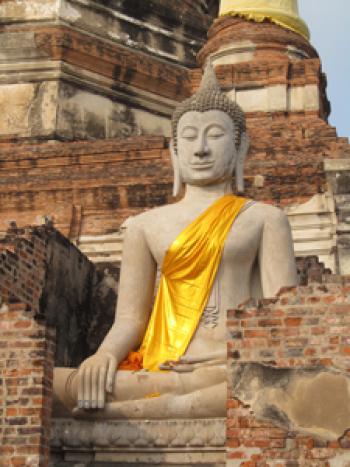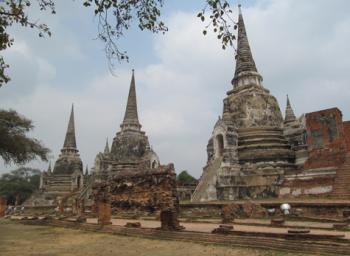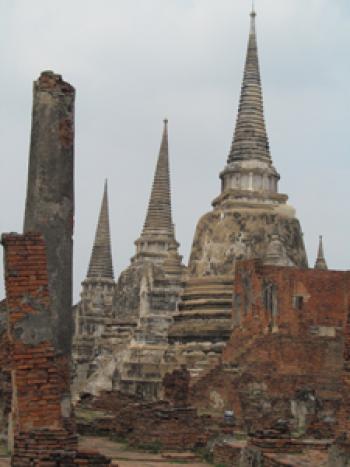Ayutthaya — island kingdom
This item appears on page 54 of the November 2016 issue.
Ayutthaya — island kingdom
Ayutthaya is one of my favorite archaeological sites. Over the past 35 years and seven or eight trips to Bangkok, I have never missed the chance to return for “one more look.” This is exactly what my husband, Paul, and I did in February 2016 on our most recent trip to Bangkok. We returned for “one more look.”
What, today, is Thailand was — at the beginning of the 14th century — a collection of mini-kingdoms, with the most powerful being Sukhothai.
In 1351, Ramathibodi I, also known as U-Thong, founded Ayutthaya as the capital of his kingdom on an island where three rivers converged north of present-day Bangkok.
U-Thong’s kingdom expanded and prospered over the next 400 years. Trade, facilitated by Ayutthaya’s strategic location, flourished. Trading partners included China, Japan, India, Persia and even European countries like France, Portugal and Holland.
There were battles with Sukhothai, with Ayutthaya finally conquering and incorporating Sukhothai into its own kingdom in 1438. At about the same time, Ayutthaya invaded and looted the Khmer kingdom at Angkor. But Ayutthaya’s days of glory and triumph ended in 1767 when a Burmese army conquered the island kingdom, destroying its palaces and temples. Ayutthaya never recovered.
If one is doing a day excursion to Ayutthaya as we did, you must choose which of the temple complexes to see, since there are so many. We chose to visit — or, in our case, revisit — our favorites and to see them in the order in which they were founded.
Saffron-draped Buddhas
Wat Yai Chai Mongkon (note that English spellings of Thai names can vary) is slightly southeast of the island that U-Thong chose for his capital. Built in 1357, it is one of the earliest temple complexes at Ayutthaya.
There’s a 203-foot-tall chedi, a bell-shaped tower that dominates the site. With four smaller chedis at its corners, this chedi represents Mount Meru, the symbolic center of the physical and spiritual universe, according to Buddhist cosmology. A saffron-draped Buddha sits beside the steep staircase leading up to the chedi.
Surrounding the chedi along four sides are rows of seated Buddhas, each draped with saffron-colored cloths, offerings from supplicants. In a corner of the temple complex is a huge, 50-foot-long reclining Buddha. It, too, is draped with an enormous saffron-colored cloth.
Buddha in a tree
On the island, itself, is Wat Mahathat, founded in 1384. The prang, or conical tower, of this temple complex is gone. It first collapsed in 1631 and was soon rebuilt. However, after its second collapse, in 1911, the prang was never rebuilt. Only the massive foundation remains, together with a smaller prang.
What most visitors go there to see is the head of a Buddha embraced by the roots of a banyan tree, a favorite subject for photographers.
Majestic prang
But if it’s prangs you want to see, Wat Rachaburana, right next door, fills the bill. It has an intact prang with a gopura, or gateway, in front of it at the top of a steep staircase. There are chedis surrounding the prang, which is decorated with nagas, serpents, and garudas, bird-like creatures.
Wat Rachaburana was supposedly built in 1424 by King Boromaracha II to commemorate his two brothers who killed each other in a bid for the throne. Their ashes are said to be interred in two of the chedis.
Sixty years ago, robbers broke into the vault beneath the prang, making off with treasures buried inside. Fortunately, not everything was taken. What remains is displayed at the Chao Sam Phraya National Museum in Ayutthaya.
Trio of chedis
Wat Phra Sri Sanphet, also on the island, was once a large palace complex. Built in 1492, it comprised throne halls, the royal residence, government offices and this temple complex that stood along one side of the immense rectangular space.
Three large chedis, each with a staircase and each with gopuras on four sides, stand shoulder to shoulder overlooking the ruins. Royal ashes supposedly lie buried within the chedis.
A few steps away from Wat Phra Sri Sanphet is Viharn Mongkhon Bophit, an active and much-visited temple. Locals place offerings there in front of one of the largest seated bronze Buddhas in Thailand.
Intimate temple
The last temple we visited was Wat Chai Watthanaram, located just off the island, southwest of the old city. Of all the wats visited on this excursion, this is the one I found most atmospheric. It’s intimate and symbolic.
A large central prang representing Mount Meru stands surrounded by four smaller prangs that represent continents. These, in turn, are enclosed within an open gallery composed of eight gateway towers with open-air passageways linking the towers. The passageways are lined with Buddhas, most of them headless.
In Buddhist cosmology, the outer eight towers represent mountains. With the long shadows of late afternoon creating interesting patterns for photography, these passageways are a great place for a final stroll before heading back to Bangkok.
If you go…
One of the reasons we love visiting Ayutthaya is it never seems oppressively crowded like some of the famous temples in Bangkok. Also, it’s so close to Bangkok that it’s easy to return on another day to see more temples. Finally, it’s the serene beauty of the temple ruins that brings us back again and again.
Generally, the hours for the temple complexes are 8 to 5. Each complex charges an admission, usually 50 baht (about $1.42 at the time of our visit).
We hired a taxi to take us to Ayutthaya to each of the temples we wanted to visit. This cost us THB3,000 ($85) for an 8-hour day that included a lunch break. Ayuttthaya is 50 miles north of Bangkok, an easy one-hour drive along good roads.
We spent a month in Bangkok in a wonderful condo rental right on the Chao Phraya River, Bangkok’s river lifeline. We chose the apartment — called Bouganville — primarily for its location beside the King Taksin Bridge, within a 10-minute taxi ride of three of our favorite river terraces for dining, those of the Shangri-La, Mandarin Oriental and Peninsula hotels.
These are among Bangkok’s best hotels, and each offers a terrace right beside the river for cocktails or for casual, elegant dining. Over the month we spent in Bangkok, we dined at these three a total of 14 times. Need I say more?
Our rental apartment was on the fourth floor of a 34-story condominium. This low floor couldn’t have been better, since, with our three balconies and every room facing the river, we had a ringside seat on all the traffic along the river — a constant procession of longtail boats, tugboats pulling barges and ferries, including the private complimentary ferry that carried condo residents across the river to the other side in less than five minutes.
The apartment consisted of a large living/dining room, two bedrooms, two-and-a-half bathrooms, a fully equipped kitchen and three balconies, one of which was set up with a table and chairs. At 3,057 square feet, it’s one of the most spacious apartments we’ve ever rented. You can view it by Googling “Bouganville Apartment Bangkok.”
We paid THB36,000 ($1,021) per week. At the time we rented, it was through TheRiverSideBangkok, but management of this apartment has now passed to Bangkok Dream Apartments (Bangkok; phone +66 851 695 518, www.bangkokdreamapartments.com).

